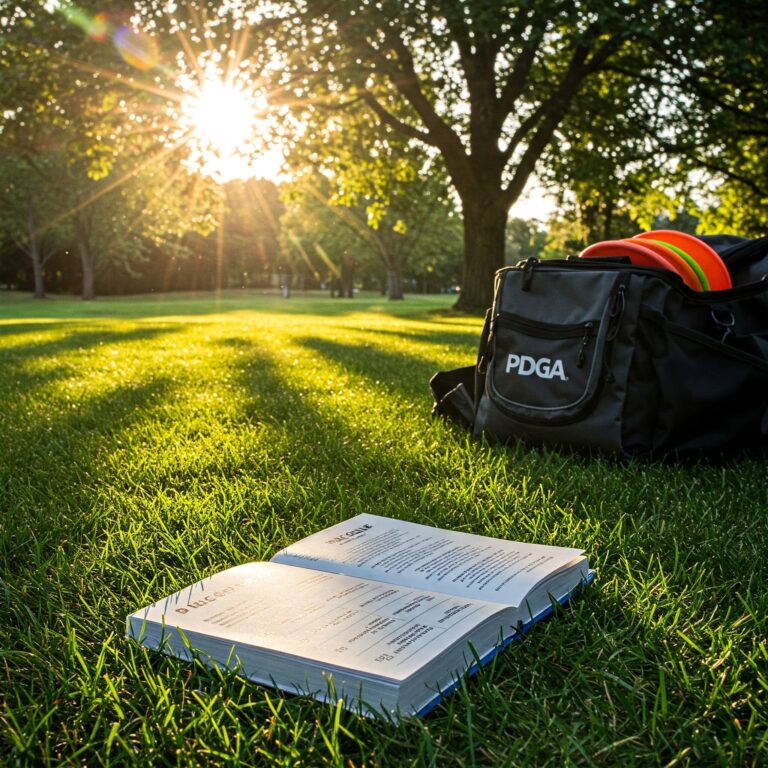Why does disc golf seem effortless for some players? It’s not just about skill; it’s about following the rules. Missing key regulations can ruin the game and lead to frustration. This guide simplifies disc golf rules, covering everything from putting to penalties, so you can focus on enjoying every throw.
Disc golf may seem simple on the surface, but mastering the rules elevates your gameplay and ensures a smooth, enjoyable experience for everyone. This guide delves into the core regulations, navigating unique situations, and essential etiquette for conquering the course.

Improving Your Gameplay with Disc Golf Rules
The 10-Meter Rule for Putting
Inside Circle 1 (10 meters or 33 feet), balance is the key to success. Players must keep control after releasing the disc and avoid stepping forward until balance is regained. This applies to all throws within 10 meters, not just putts. This means you can’t use any supporting point (knee, foot, etc.) to touch a spot in front of your lie until you’ve completed your putt and established full control of your balance.
Respect for your fellow players is equally important on the course, especially during putting. Silence is golden while others are lining up their putt. Minimize distractions by avoiding unnecessary movement or loud conversations. By adhering to these principles of etiquette, you create a calm and respectful environment that allows everyone to focus on sinking those putts.
Respect and Fair Play in Disc Golf
Disc golf is built on mutual respect and fair play. This “golden rule” translates to treating others on the course with courtesy, just as you’d like to be treated. This includes respecting the environment, yielding to faster groups, and maintaining a positive attitude that fosters a welcoming atmosphere.
Starting Disc Golf with Practical Tips
Learning the Basics of Disc Golf
Disc golf may appear simple at first glance. Players throw discs from designated tee pads towards a basket (hole) in as few throws as possible. Each hole has a par, indicating the expected number of throws. Keep track of your throws on a scorecard – the player with the lowest overall score wins!
Strategies and techniques come into play as you progress. Understanding different disc types and their flight patterns is essential. Explore backhands, forehands, and rollers to navigate challenging layouts and wind conditions. Remember, patience is key – focus on improvement, and consistent birdies will follow.
Dealing with Unique Situations in Disc Golf
Understanding Mercy in Disc Golf
Now, let’s explore some situations that might leave you scratching your head. Is there a “mercy rule” in disc golf? Nope! The goal is to complete each hole in the fewest throws possible. However, fair play and sportsmanship still reign supreme. If a fellow player is having a particularly rough hole, it’s customary to offer encouragement and maintain a positive vibe.
Lost Disc? Here’s What to Do
Misplaced a disc? You have three minutes to search before it’s declared lost. Fellow players can help during this time. If it’s truly gone, take a one-stroke penalty and re-throw from your last position.
- Search diligently within a reasonable timeframe, typically three minutes. Etiquette dictates that your fellow players should help you search for it.
- Inform other players and course officials, if applicable.
- Most courses have lost and found procedures – inquire with the course management.
Minimize disc loss by writing your name and contact information on the bottom of the disc.

Mandatory Routes (Mandos)
Mandos define the required path for your disc. Missing a mando results in a penalty stroke and re-throwing from the drop zone or the last legal position.
Equipment Rules and Legal Disc Throws
Identifying Illegal Discs
Disc golf uses PDGA-approved discs for standardized competition. Discs with excessive wear, modifications that alter flight characteristics (like added weights), or extreme damage are considered illegal. Always check tournament regulations for specific disc restrictions.
Clarifying Throw Violations
A foot fault occurs when a player violates the throwing stance limitations during a throw. This can involve stepping or reaching outside the designated area. Penalties vary depending on the fault’s severity (warning, stroke penalty, or hole loss).
Determining Winners and Losers
Disc golf scoring is typically cumulative. The player with the lowest total number of throws across all holes emerges victorious. Ties are usually broken with a playoff on a designated hole. Tournaments might utilize modified scoring formats, so be sure to check the specific rules beforehand.
Interference and Misplay
If interference occurs from spectators, animals, or other players, the throw can be replayed without a penalty. If a player misplays by throwing from the wrong spot, the penalty depends on the tournament’s specific rules.
When Your Disc Gets Stuck in a Tree
The two-meter rule is optional and decided by the Tournament Director. If active, a disc stuck more than two meters (6 feet 7 inches) above the ground results in a one-stroke penalty. Without this rule, it’s no penalty—just retrieve your disc and continue.
- Generally Not a Penalty: If the tree is considered “in-bounds” (playable area) according to the course map, and there’s no “two-meter rule” in effect for that specific course or hole, there’s no penalty. Just retrieve your disc safely and continue playing.
- The Two-Meter Rule (Optional): This rule is entirely at the Tournament Director’s discretion. It applies when a disc lands at least two meters (approximately 6 feet 7 inches) above the ground, measured from the disc’s lowest point. If the two-meter rule is active and your disc gets stuck above that height in a tree, you’ll incur a one-stroke penalty. However, unlike retrieving from directly below the tree, your re-throw position would be from the ground directly below where the disc landed (assuming it’s still in-bounds).
- Out of Bounds: The only time a disc stuck in a tree becomes a penalty is if it lands “out of bounds” (designated unplayable area) according to the course rules. In that case, you’ll receive a one-stroke penalty.
Remember: Always check with the Tournament Director for clarification on course-specific rules and the two-meter rule’s status.
Out-of-Bounds Areas
Out-of-bounds throws come with a one-stroke penalty. Drop your disc one meter (3 feet) inside the boundary or the closest playable spot. Casual water, like puddles, allows free relief without penalty.
Clearing Up Myths About Chains and Scoring
The electrifying clang of chains reverberates through the course – a disc golfer’s dream! But does it always translate to a successful putt? Here, we debunk common misconceptions surrounding scoring and chain interactions:
- Myth: Hitting the chains automatically guarantees a made putt.
- Fact: While an impressive feat, hitting the chains only signifies a close call. The disc must ultimately rest within the basket for a successful putt.
- Myth: The number of chain hits determines the score.
- Fact: Your score solely depends on the number of throws it takes to get the disc in the basket, regardless of how many chains it rattles on the way in.
- Myth: A disc bouncing out of the basket after hitting chains counts as a made putt.
- Fact: Unfortunately, no! The disc needs to come to a complete stop entirely within the basket for a successful putt.
Understanding these scoring nuances ensures accurate tracking and avoids confusion during gameplay.
Understanding Fair Play in Disc Golf Competitions
The spirit of disc golf thrives on fair play and mutual respect. This section delves deeper into this essential concept:
- Respect Your Opponents: Treat fellow players with courtesy, just as you’d like to be treated. Acknowledge good throws, offer positive encouragement, and maintain a friendly demeanor throughout the competition.
- Adhere to the Rules: Understanding and following the PDGA rules is crucial. If unsure about a situation, call a courtesy violation on yourself. Don’t hesitate to ask for clarification from the Tournament Director if needed.
- Maintain Integrity: Sportsmanship extends beyond written rules. Avoid distractions during others’ throws, prioritize safety, and strive to uphold the positive image of the sport.
By embracing these principles, you contribute to a fair and enjoyable competitive environment for everyone.
Handling Penalties in Disc Golf Rules
Even the most seasoned disc golfers encounter situations that might incur penalties. Here’s a breakdown of common scenarios and their consequences:
- Foot Faults: Stepping or reaching outside the designated throwing area during a throw constitutes a foot fault. Penalties vary depending on the severity, ranging from a warning to a stroke penalty or even hole loss.
- Out-of-Bounds Throws: If your disc lands in a designated unplayable area (out-of-bounds), you’ll incur a penalty stroke. The specific penalty procedure might involve re-throwing from the designated tee area or a designated re-throw zone.
- Disc Lost: As mentioned earlier, failing to find your disc within a reasonable timeframe (typically around three minutes) results in a one-stroke penalty. You can then re-throw from the original throwing lie or take a drop throw (incurs an additional penalty stroke) near where the disc went missing.
Understanding these common penalties and their enforcement ensures smooth gameplay and fair consequences for any rule violations.
Course Etiquette for Disc Golf Players
Etiquette on the disc golf course goes beyond following the written rules. It’s about being a considerate and respectful player, enhancing the experience for everyone. Here are some key aspects of proper course etiquette:
- Maintain Pace of Play: Be mindful of the group behind you. If a hole is clear, allow faster groups to play through politely. Avoid unnecessary delays, and keep your throws moving at a reasonable pace.
- Minimize Distractions: Maintain silence and avoid creating distractions while others are throwing. This includes excessive noise, movement, or cellphone use that might disrupt their focus.
- Yield to Groups Ahead: If you catch up to a slower group, politely ask if you can play through. Wait patiently for them to finish the hole before proceeding.
- Respect the Course: Treat the course with care. Avoid littering or damaging trees, plants, or tee pads. Fill in divots created by your throws and repair any footprints in sand traps (if applicable).
- Clean Up After Yourself: Dispose of any trash you generate during your game. This includes empty water bottles, wrappers, or scorecards. Leave the course looking as good, or even better, than you found it.
Adaptive Rules and Team Play
Adaptive rules let players with disabilities enjoy disc golf. This can include modified stances or visual aids. In team formats like doubles, players alternate throws, strategising together for the best score. These variations add fun and inclusivity to the sport.
Adaptive Rules, Equipment, and Team Play
Disc golf is for everyone, and the sport’s flexibility proves it. Adaptive rules accommodate players with physical or sensory challenges. For example, a visually impaired player might use a guide to assist in lining up throws, while wheelchair users can modify their stance to suit their abilities. These rules ensure fairness while fostering inclusivity.
Team play is another exciting variation. In doubles, two players work as a team, alternating throws to score as low as possible. It’s not just fun—it’s a great way to learn from each other’s strategies.
Equipment matters, too. PDGA-approved discs ensure fair play. Avoid heavily modified or damaged discs, as they might violate regulations. A good rule of thumb: if you’re unsure about your disc’s legality, check with tournament officials before your first throw.
As you venture further into the world of disc golf, remember, the journey is just as rewarding as the destination. Embrace the challenge of mastering new throws, celebrate the camaraderie of fellow players, and most importantly, have fun! Disc golf offers a unique blend of athleticism, strategic thinking, and connection with the outdoors. With the knowledge you’ve gained from this guide, you’re well on your way to navigating the course with confidence and becoming a respectful player. So, grab your discs, step onto the course, and get ready to experience the thrill of the flight!
Common Questions About Disc Golf Rules
Disc golf rules include throwing a disc towards the basket in as few throws as possible. You must stay within bounds, respect mandatory routes, and keep track of your score. Following course etiquette, such as letting faster groups play through, ensures a fair and enjoyable game.
The two-meter rule is optional and decided by the Tournament Director. If active, a disc stuck more than two meters (6 feet 7 inches) above the ground results in a one-throw penalty. Otherwise, you retrieve your disc without a penalty.
If your disc lands out of bounds, you take a one-throw penalty. Resume play by dropping the disc one meter (3 feet) inside the boundary or at the closest playable spot. For casual water, free relief is allowed without penalties.
Disc golf’s adaptive rules allow modifications for players with disabilities. These include adjusted stances for wheelchair users and visual aids for those with visual impairments. The goal is to make the game accessible while maintaining fairness.
Mandatory routes, or mandos, require your disc to follow a specific path. Missing a mando results in a penalty throw and a re-throw from the drop zone or your last legal position. Mandos are marked on the course map and must be followed to avoid penalties.




